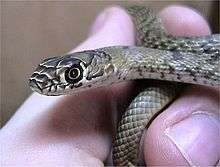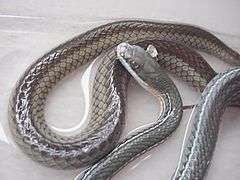Masticophis
Masticophis is a genus of colubrid snakes, commonly referred to as whip snakes or coachwhips, which are endemic to the Americas.[2] They are characterized by having a long, thin body and are not dangerous to humans.
| Masticophis | |
|---|---|
 | |
| Masticophis flagellum testaceus, western coachwhip, juvenile | |
| Scientific classification | |
| Kingdom: | Animalia |
| Phylum: | Chordata |
| Class: | Reptilia |
| Order: | Squamata |
| Suborder: | Serpentes |
| Family: | Colubridae |
| Subfamily: | Colubrinae |
| Genus: | Masticophis Baird & Girard, 1853 |
| Species | |
|
Ten, see text. | |
| Synonyms | |
|
Bascanion, Bascanium, Coluber, Coryphodon, Drymobius, Herpetodryas, Leptophis, Liophis, Natrix, Psammophis, Zamenis [1] | |
Geographic range
Species of Masticophis are found in the United States, Mexico, Central America, and northern South America.[2]
Description
Adults of species in the genus Masticophis may attain a total length (including tail) from 152 cm (5 ft) for M. lateralis to 259 cm (8.5 ft) for M. flagellum. A distinctive character of this genus is the shape of the frontal scale (the large scale in the center of the upper surface of the head) which is bell-shaped and elongated. At the rear of the body, the dorsal scales are arranged in only 13 rows.[3]
Species and subspecies
The genus Masticophis contains eleven species that are recognized as being valid, five of which have recognized subspecies.[4]
- Masticophis anthonyi (Stejneger, 1901) – Clarion Island whip snake
- Masticophis aurigulus (Cope, 1861) – Baja California striped whip snake
- Masticophis barbouri (Van Denburgh & Slevin, 1921)
- Masticophis bilineatus Jan, 1863 – Sonoran whip snake
- Masticophis flagellum (Shaw, 1802) – coachwhip
- Masticophis flagellum cingulum Lowe & Woodin, 1954 – Sonoran coachwhip
- Masticophis flagellum flagellum (Shaw, 1802) – eastern coachwhip
- Masticophis flagellum lineatulus H.M. Smith, 1941 – lined coachwhip
- Masticophis flagellum piceus (Cope, 1892) – red coachwhip
- Masticophis flagellum ruddocki Brattstrom & Warren, 1953 – San Joaquin coachwhip
- Masticophis flagellum testaceus (Say, 1823) – western coachwhip
- Masticophis fuliginosus (Cope, 1895) – Baja California coachwhip
- Masticophis lateralis (Hallowell, 1853 – California whipsnake
- Masticophis lateralis euryxanthus Riemer, 1954 – Alameda striped racer
- Masticophis lateralis lateralis (Hallowell, 1853) – California striped racer

- Masticophis mentovarius (A.M.C. Duméril, Bibron & A.H.A. Duméril, 1854) – neotropical whip snake
- Masticophis schotti Baird & Girard, 1853 – Schott's whip snake
- Masticophis schotti ruthveni Ortenburger, 1923 – Ruthven's whip snake
- Masticophis schotti schotti Baird & Girard, 1853 – Schott's whip snake
- Masticophis slevini (Lowe & Norris, 1955)
- Masticophis taeniatus (Hallowell, 1852) – striped whip snake
- Masticophis taeniatus girardi (Stejneger & Barbour, 1917) – Central Texas whip snake
- Masticophis taeniatus taeniatus (Hallowell, 1852) – desert striped whip snake
Nota bene: A binomial authority or trinomial authority in parentheses indicates that the species or subspecies was originally described in a genus other than Masticophis.
References
| Wikimedia Commons has media related to Masticophis. |
- Wright AH, Wright AA (1957). Handbook of Snakes of the United States and Canada. Ithaca and London: Comstock. 1,105 pp. (in 2 volumes). (Genus Masticophis, pp. 423-425).
- Conant R (1975). A Field Guide to Reptiles and Amphibians of Eastern and Central North America, Second Edition. Boston: Houghton Mifflin. xviii + 429 pp. ISBN 0-395-19977-8 (paperback). (Genus Masticophis, pp. 177-178).
- Smith HM, Brodie ED Jr (1982). Reptiles of North America: A Guide to Field Identification. New York: Golden Press. 240 pp. ISBN 0-307-13666-3 (paperback). (Genus Masticophis, pp. 190-193).
- "Masticophis ". The Reptile-Database. www.reptile-database.org.
Further reading
- Baird SF, Girard C (1853). Catalogue of North American Reptiles in the Museum of the Smithsonian Institution. Part I.—Serpents. Washington, District of Columbia: Smithsonian Institution. xvi + 172 pp. (Masticophis, new genus, p. 98).
- https://serpientesdevenezuela.org/masticophis-mentovarius/
External links
- Genus Coluber at The Reptile Database.